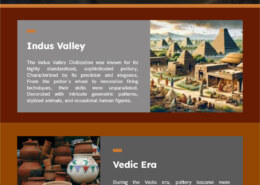Roadmap for Answer Writing Introduction Briefly introduce the significance of pottery in ancient India. State the focus on the evolution of pottery styles from the Indus Valley Civilization to the later Vedic period and their connection to socio-cultural aspects. Harappan Pottery Describe the main characteristics ...
Pottery holds significant importance in rituals across various cultures, influencing cultural traditions in multiple ways: Ceremonial Objects: Many cultures use pottery as essential components in rituals, such as religious ceremonies, weddings, and funerals. Specific forms, like urns or ceremonial vRead more
Pottery holds significant importance in rituals across various cultures, influencing cultural traditions in multiple ways:
- Ceremonial Objects: Many cultures use pottery as essential components in rituals, such as religious ceremonies, weddings, and funerals. Specific forms, like urns or ceremonial vessels, often carry deep symbolic meanings, serving as vessels for offerings or the ashes of the deceased, thus connecting the physical and spiritual realms.
- Cultural Identity: Pottery often reflects the unique artistic styles and techniques of a culture, reinforcing a sense of identity and continuity. Distinctive pottery styles can signal community belonging and cultural heritage, helping to preserve traditions through generations.
- Functional and Symbolic Roles: Beyond their practical uses, pottery items are imbued with cultural significance. For instance, the design and decoration of a pot may convey stories, myths, or social values, serving as a medium for cultural expression and communication.
- Social Cohesion: The act of creating pottery can foster community ties. Many rituals involve communal pottery-making, strengthening social bonds and encouraging collaboration. This shared activity can also pass down techniques and traditions, ensuring cultural continuity.
- Ritualistic Performance: Pottery often plays a role in performance-based rituals, such as dances or reenactments. The use of specific vessels during these performances can heighten the symbolic meaning, enhancing the audience’s connection to the culture.
- Adaptation and Change: While pottery often embodies tradition, it can also adapt to changing cultural contexts. New materials, techniques, or aesthetic influences may be integrated into traditional pottery practices, reflecting broader social transformations while still honoring heritage.
- Cross-Cultural Connections: Pottery serves as a point of connection between cultures, revealing shared human experiences through ritualistic use. The exchange of pottery styles and practices can promote understanding and appreciation across different cultural groups.
In summary, pottery is not just a functional object; it is a profound cultural artifact that encapsulates history, identity, and community. Its role in rituals and cultural traditions underscores the interconnectedness of art, spirituality, and social life, highlighting how material culture shapes human experience.
See less

Model Answer Introduction The development of pottery styles in India from the Indus Valley Civilization to the later Vedic period is closely tied to the socio-cultural life of its people. Harappan Pottery The Harappans primarily created Polished Ware Pottery characterized by rough surfaces. Their poRead more
Model Answer
Introduction
The development of pottery styles in India from the Indus Valley Civilization to the later Vedic period is closely tied to the socio-cultural life of its people.
Harappan Pottery
The Harappans primarily created Polished Ware Pottery characterized by rough surfaces. Their pottery often featured redware adorned with black geometric designs, as well as depictions of flora and fauna. Much of this pottery was wheel-thrown, although handmade varieties also existed. The everyday utility of pottery led to flat bases for practical use.
Late Harappan Developments
During the Late Harappan period (1900 BC – 1200 BC), Ochre Coloured Pottery (OCP) emerged, produced on slow wheels, and displayed elements of chalcolithic culture. Sites in the Swat Valley yielded black-on-red painted pottery, and both grey-ware and painted grey-ware, linked to the Vedic people, were found alongside late Harappan pottery.
Vedic Era Pottery
The Vedic era introduced the Painted Grey Ware (PGW) culture (1200 BC – 600 BC), primarily found in the Gangetic plain and Ghaggar-Hakra valley, with Mathura as a significant site. PGW is noted for fine grey pottery featuring black geometric patterns, largely confined to regions like Punjab and Haryana.
Later Vedic Era – NBPW
By the end of the later Vedic age, Northern Black Polished Ware (NBPW) emerged, recognized for its glossy finish and association with elite society. This pottery type indicates social stratification, with intricate designs suggesting higher social status. Both monochrome and bichrome varieties of NBPW were prevalent.
Socio-Cultural Significance of Pottery
Pottery serves as a vital tool for understanding cultural and social dynamics. The complexity of designs often reflects the societal class, with elaborate pottery indicating wealth and status. Burial sites containing pottery reveal social distinctions and the prosperity of settlements. For example, black-grey burnished ware from Swat Valley shares similarities with north Iranian pottery, highlighting cultural exchanges.
In conclusion, the evolution of pottery in India not only illustrates artistic progress but also offers insights into the socio-cultural fabric of ancient societies.
See less